Requirements Life Cycle Management
Chapter 5. Requirements Life Cycle Management

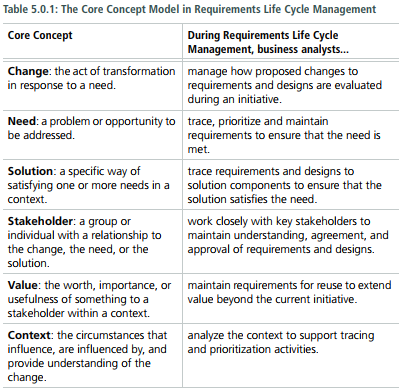
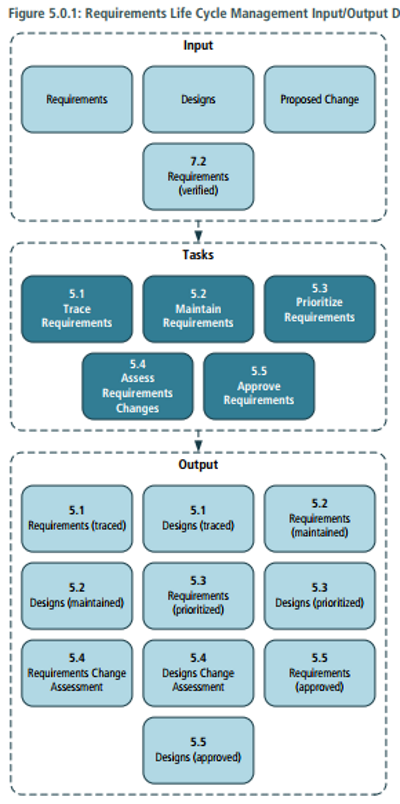
Each Task in the BABOK Guide is presented in the following format:
- Purpose >
- Description >
- Inputs >
- Elements >
- Guidelines / Tools >
- Techniques >
- Stakeholders >
- Outputs >
1. Trace Requirements
- Purpose > The purpose of Trace Requirements is to ensure that requirements and designs at different levels are aligned to one another, and tp manage the effects of change to one level on related requirements.
- Description > Requirements traceability indentifies and documents the lineage of each requirement, including its backward tracebility, its forward tracebility, and its relationship to other requirements. Tracebility requirement is used to help ensure that the solution conforms to requirements and assist in scope, change, risk, time, cost, and communication management. It is also used to detect missing functionality or to identify if there is implemented functionality that is not supported by any requirement.
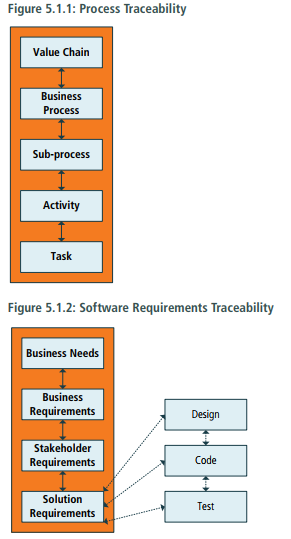
- Inputs > Requirements > Designs
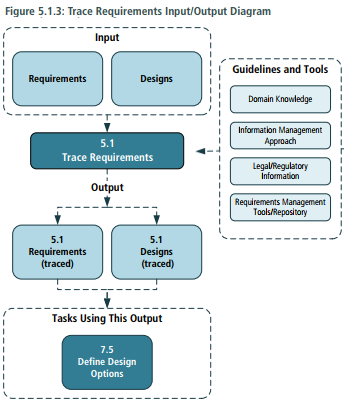
- Elements > Level of Formality > Relationships (derive/ depends/ satisfy/ validate) > Traceability Repository
- Guidelines / Tools > Domain Knowlegde > Information Management Approach > Legal / Regulatory Information > Requirements Management Tools/ Repository
- Techniques > Business Rules Analysis > Functional Decomposition > Process Modelling > Scope Modelling
- Stakeholders > Customers > Domain Subject Matter Expert > End User > Implementation Subject Matter Expert > Operational Support > Project Manager > Sponsor > Suppliers > Tester
- Outputs > Requirements (traced): have clearly defined relationships to other requirements, solution components, or releases, phases, or iterations, within a solution scope, such that coverage and the effects of change are clearly. > Designed (trace): clearly defined relationships to other requirements, solution components, or releases, phases, or iterations, within a solution scope, such that coverage and effects of change are clearly indentifiable.
2. Maintain Requirements
- Purpose > The purpose of Maintain Requirements is to retain requirement accurary and consistancy throughout and beyond the change during the entire requirements life cycle, and to support reuse of requirements in other solutions.
- Description > A requirement that represents an ongoing need must be maintained to ensure that it remains valid over time.
- Inputs > Requirements > Designs
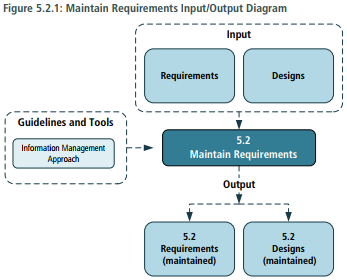
- Elements > Maintain Requirements > Maintain Attributes > Reusing Requirements
- Guidelines / Tools > Information Management Approach
- Techniques > Business Rules Analysis > Data Flow Diagrams > Data Modelling > Document Analysis > Functional Decomposition > Process Modelling > Use Cases and Scenarios > User Stories
- Stakeholders > Domain Subject Matter Expert > Implementation Subject Matter Expert > Operational Support > Regulator > Tester
- Outputs > Requirements (maintained): defined once and available for long-term usage by the organization. They may become organizational process asset or be used in future initiatives. In some cases, a requirement that was not approved or implemented may be maintained for a possible future initiative. > Designs (maintained): may be reusable once defined. For example, as a self-contained component that can be made available for possible future use.
3. Prioritize Requirements
- Purpose > The purpose of Prioritize Requirements is to rank requirements in the order of relative importance.
- Description > Prioritization is the act of ranking requirements to determine their relative importance to stakeholders. When a requirement is proritizes, it si given greater or lesser priority. Priority can refer to the relative value of a requirement, or to the sequence in which it will be implemented. Prioritization is an ongoing process, with priorities changing as the context changes.
- Inputs > Requirements > Designs

- Elements > Basis for Prioritization (benefit/ penalty/ cost/ risk/ dependencies/ time sensitivity/ stability/ regulatory or policy compliance) > Challenges of Prioritization > Continual Prioritization
- Guidelines / Tools > Business Constraints > Change Strategy > Domain Knowlegde > Governance Approach > Requirements Architecture > Requirements Management Tools/ Repository> Solution Scope
- Techniques > Backlog Management > Business Cases > Decision Analysis > Estimation > Financial Analysis > Interviews > Item Tracking > Prioritization > Risk Analysis and Management > Workshops
- Stakeholders > Customer > End User > Implementation Subject Matter Expert > Project Manager > Regulator > Sponsor
- Outputs > Requirements (prioritized): prioritized or ranked requirements are availble for additional work, ensuring that the highest valued requirements are addressed first. > Designs (priorirized): prioritized or ranked designs are availble for additional work, ensuring that the highest valued designs are addressed first.
4. Assess Requirements Changes
- Purpose > The purpose of Assess Requirements Changes is to evaluate the implications of proposed changes to requirements and designs.
- Description > The Assess Requirements Changes task is performed as new needs or possible solutions are identified. These may or may not align to the change strategy and/or solution scope. Assessment must be performed to determine whether a proposed change will increase the value of the solution, and if so, what action should be taken.
- Inputs > Proposed Change > Requirements > Designs
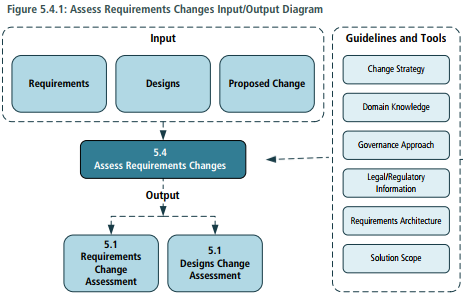
- Elements > Assessment Formality > Impact Analysis (benefit/ cost/ impact/ schedule/ urgency) > Impact Resolution
- Guidelines / Tools > Change Strategy > Domain Knowlegde > Governance repproach > Legal/ Regulator Information > Requirements Architecture > Solution Scope
- Techniques > Bsiness Cases > Business Rules Analysis >Decision Analysis > Document Analysis > Estimation > Financial Analysis > Interface Analysis > Interviews > Item Tracking > Risks Analysis and Management > Workshops
- Stakeholders > Customer > Domain Subject Matter Expert > End User > Operational Support > Project Manager > Regulator > Sponsor > Tester
- Outputs > Requirements Change Assessment: the recommendation to approve, modify, or deny a proposed change to requirements. > Designs Change Assessment: the recommendation to approve, modify, or deny a proposed change to design components.
5. Approve Requirements
- Purpose > The purpose of Approve Requirements is to obtain agreement on and approval of requirements and designs for business analysis work to continue and/or solution construction to proceed.
- Description > Business analysts are responsible for ensure clear communication of requirements, designs, and other business analysis information to the key stakeholders reponsible for approving that information.
- Inputs > Requirements (verified) > Designs
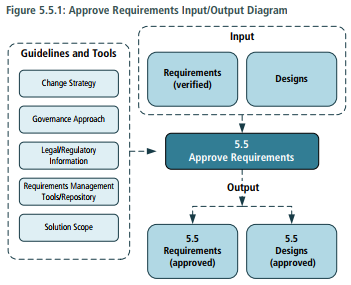
- Elements > Understand Stakeholder Roles > Conflict and Issue Management > Gain Consensus > Track and Communicate Approval
- Guidelines / Tools > Change Strategy > Governace Approach > Legal/ Regulatory Information > Requirement Management Tools/ Repository > Solution Scope
- Techniques > Acceptance and Evaluation Criteria > Decision Analysis > Item Tracking > Reviews > Workshops
- Stakeholders > Customer > Domain Subject Matter Expert > End User > Operational Support > Project Manager > Regulator > Sponsor > Tester
- Outputs > Requirements (approved): requirements which are agreed to y stakeholders, and are ready for use in subsequent business analyst efforts. > Designs (approved): which are agreed to y stakeholders, and are ready for use in subsequent business analyst or solution development efforts.